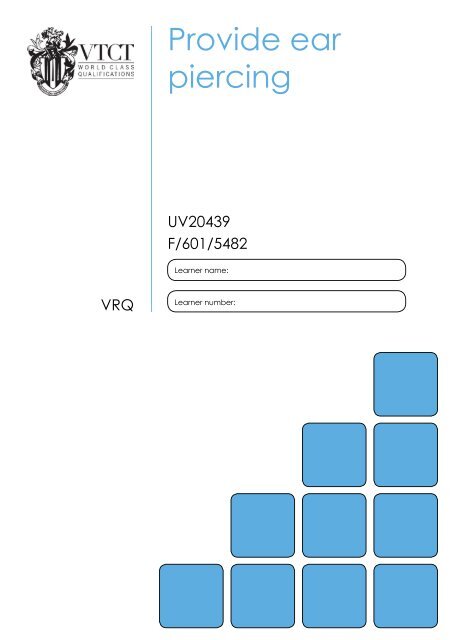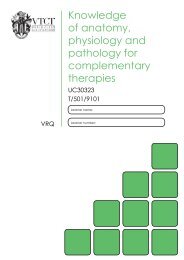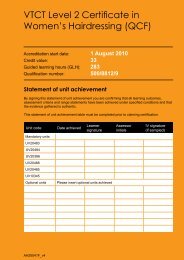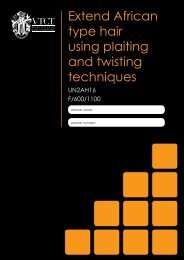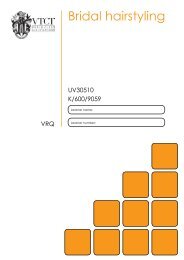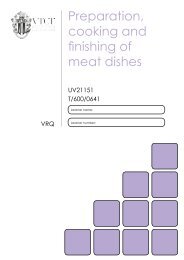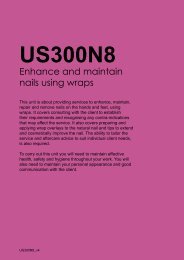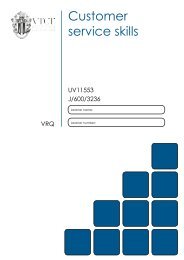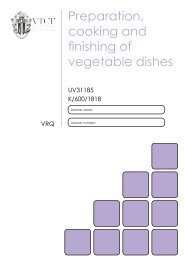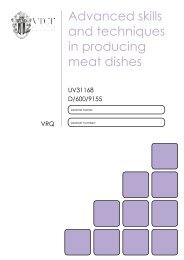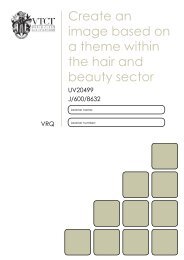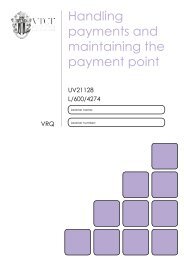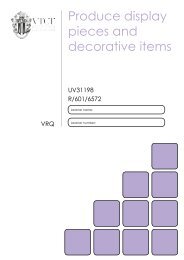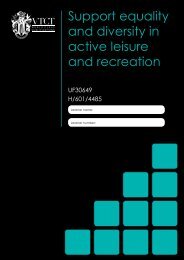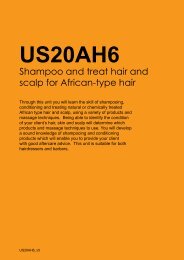You also want an ePaper? Increase the reach of your titles
YUMPU automatically turns print PDFs into web optimized ePapers that Google loves.
VRQ<br />
<strong>Provide</strong> <strong>ear</strong><br />
<strong>piercing</strong><br />
UV20439<br />
F/601/5482<br />
L<strong>ear</strong>ner name:<br />
L<strong>ear</strong>ner number:
Statement of unit achievement<br />
<strong>VTCT</strong> is the specialist awarding body for the Hairdressing, Beauty Therapy,<br />
Complementary Therapy and Sport and Active Leisure sectors, with over 45<br />
y<strong>ear</strong>s of experience.<br />
<strong>VTCT</strong> is an awarding body regulated by national organisations including<br />
Ofqual, SQA, DCELLS and CCEA.<br />
<strong>VTCT</strong> is a registered charity investing in education and skills but also giving to<br />
good causes in the area of facial disfigurement.<br />
By signing this statement of unit achievement you are confirming that all l<strong>ear</strong>ning outcomes, assessment<br />
criteria and range statements have been achieved under specified conditions and that the evidence<br />
gathered is authentic.<br />
This statement of unit achievement table must be completed prior to claiming certification.<br />
Unit code Date achieved L<strong>ear</strong>ner signature<br />
Assessor tracking table<br />
Assessor name Assessor signature<br />
Assessor<br />
initials<br />
Assessors<br />
initials<br />
IV signature<br />
(if sampled)<br />
All assessors using this Record of Assessment book must complete this table. This is required for<br />
verification purposes.<br />
Assessor number<br />
(optional)
UV20439<br />
<strong>Provide</strong> <strong>ear</strong> <strong>piercing</strong><br />
This unit is about <strong>ear</strong> <strong>piercing</strong> of the lobe area only, and<br />
the skills and knowledge necessary to carry out such work.<br />
You will need to use a variety of equipment, materials and<br />
products safely and correctly for this work. You will also<br />
need to provide clients with aftercare advice concerning the<br />
use of aftercare products, moving and removal of the stud<br />
and possible contra-actions.<br />
UV20439_v7
Level<br />
Credit value<br />
GLH<br />
2<br />
2<br />
17<br />
Observation(s)<br />
2<br />
External paper(s)<br />
1
<strong>Provide</strong> <strong>ear</strong> <strong>piercing</strong><br />
L<strong>ear</strong>ning outcomes Evidence requirements<br />
On completion of this unit you will:<br />
1. Be able to prepare for <strong>ear</strong> <strong>piercing</strong> services<br />
2. Be able to provide <strong>ear</strong> <strong>piercing</strong> services<br />
1. Environment<br />
Evidence for this unit must be gathered in a<br />
real or realistic working environment.<br />
2. Simulation<br />
Simulation is not allowed in this unit.<br />
3. Observation outcomes<br />
Competent performance of ‘Observation’<br />
outcomes must be demonstrated to your<br />
assessor on at least two occasions.<br />
4. Range<br />
All ranges must be practically demonstrated<br />
or other forms of evidence produced to<br />
show they have been covered.<br />
5. Knowledge outcomes<br />
There must be evidence that you possess<br />
all the knowledge and understanding<br />
listed in the ‘Knowledge’ section of this<br />
unit. This evidence may include projects,<br />
assignments, case studies, reflective<br />
accounts, oral/written questioning and/or<br />
other forms of evidence.<br />
6. Tutor/Assessor guidance<br />
You will be guided by your tutor/assessor<br />
on how to achieve l<strong>ear</strong>ning outcomes and<br />
ranges in this unit. All outcomes and ranges<br />
must be achieved.<br />
7. External paper<br />
Knowledge and understanding in this unit<br />
will be assessed by an external paper.<br />
The criteria that make up this paper are<br />
highlighted in white throughout this unit.<br />
There is one external paper that must be<br />
achieved.<br />
UV20439<br />
3
4<br />
Achieving observations<br />
and range<br />
Achieving observation outcomes<br />
Your assessor will observe your performance<br />
of practical tasks. The minimum number<br />
of observations required is indicated in the<br />
evidence requirements section of this unit.<br />
Criteria may not always naturally occur during<br />
a practical observation. In such instances you<br />
will be asked questions to demonstrate your<br />
competence in this area. Your assessor will<br />
document the criteria that have been achieved<br />
through oral questioning.<br />
Your assessor will sign off an outcome when all<br />
criteria have been competently achieved in a<br />
single client service.<br />
Achieving range<br />
The range section indicates what must<br />
be covered. Ranges should be practically<br />
demonstrated as part of an observation. Where<br />
this is not possible other forms of evidence may<br />
be produced. All ranges must be covered.<br />
Your assessor will document the portfolio<br />
reference once a range has been competently<br />
achieved.<br />
UV20439<br />
Maximum service times<br />
The following maximum service times apply to<br />
this unit:<br />
Ear <strong>piercing</strong> 15 minutes
Outcome 1<br />
Be able to prepare for <strong>ear</strong> <strong>piercing</strong> services<br />
You can:<br />
a. Prepare yourself, the client and work area<br />
for <strong>ear</strong> <strong>piercing</strong><br />
b. Use suitable consultation techniques to<br />
identify treatment objectives<br />
c. <strong>Provide</strong> cl<strong>ear</strong> recommendations to the client<br />
d. Select products, tools and equipment to suit<br />
client treatment needs<br />
*May be assessed through oral questioning.<br />
Observations<br />
Observation 1 2 Optional<br />
Date achieved<br />
Criteria questioned orally<br />
Portfolio reference<br />
Assessor initials<br />
L<strong>ear</strong>ner signature<br />
UV20439 5
6<br />
Outcome 2<br />
Be able to provide <strong>ear</strong> <strong>piercing</strong> services<br />
You can:<br />
a. Communicate and behave in a professional<br />
manner<br />
b. Follow health and safety working practices<br />
c. Position yourself and the client correctly<br />
throughout the treatment<br />
d. Use tools, equipment and techniques to suit<br />
clients and their treatment needs<br />
e. Complete the treatment to the satisfaction<br />
of the client<br />
f. Record the results of the treatment<br />
g. <strong>Provide</strong> suitable aftercare advice<br />
*May be assessed through oral questioning.<br />
Observation<br />
Date achieved<br />
Criteria questioned orally<br />
Portfolio reference<br />
Assessor initials<br />
L<strong>ear</strong>ner signature<br />
1 2 Optional<br />
UV20439
*You must practically demonstrate that you have:<br />
Range<br />
Used all consultation techniques Portfolio reference<br />
Questioning<br />
Visual<br />
Manual<br />
Reference to client records<br />
Dealt with a minimum of 1 of the necessary actions Portfolio reference<br />
Encouraging clients to seek medical advice<br />
Explaining why the service cannot be carried out<br />
Modifying the treatment<br />
Used all types of equipment, materials and products Portfolio reference<br />
Ear <strong>piercing</strong> gun<br />
Sterile skin marker pen<br />
Sterile <strong>ear</strong> studs<br />
Mirror<br />
Consumables<br />
<strong>Provide</strong>d all types of treatment advice Portfolio reference<br />
Suitable home care products and their use<br />
Regular movement of the studs<br />
Possible contra-actions<br />
Removal of studs<br />
*It is strongly recommended that all range items are practically demonstrated. Where this is not<br />
possible, other forms of evidence may be produced to demonstrate competence.<br />
UV20439 7
8<br />
Developing knowledge<br />
Achieving knowledge outcomes<br />
You will be guided by your tutor and assessor<br />
on the evidence that needs to be produced.<br />
Your knowledge and understanding will be<br />
assessed using the assessment methods listed<br />
below:<br />
• Observed work<br />
• Witness statements<br />
• Audio-visual media<br />
• Evidence of prior l<strong>ear</strong>ning or attainment<br />
• Written questions<br />
• Oral questions<br />
• Assignments<br />
• Case studies<br />
Achieving the external paper<br />
Where possible your assessor will integrate<br />
knowledge outcomes into practical observations<br />
through oral questioning.<br />
The external paper will test your knowledge of the criteria highlighted in white. A pass mark of<br />
70% must be achieved. Criteria not achieved will be identified to your tutor/assessor. You will then<br />
be orally questioned or asked to produce other forms of evidence as all unit criteria must<br />
be achieved.<br />
Your assessor will complete the following table when the 70% pass mark has been achieved.<br />
Paper Date achieved Assessor initials<br />
1 of 1<br />
UV20439
Knowledge<br />
Outcome 1<br />
Be able to prepare for <strong>ear</strong> <strong>piercing</strong> services<br />
You can:<br />
e. Describe the environmental conditions suitable for <strong>ear</strong> <strong>piercing</strong><br />
f. Describe different consultation techniques used to identify<br />
treatment objectives<br />
g. Describe how to select products, tools and equipment to suit client<br />
treatment needs<br />
h. Describe the contra-indications to <strong>ear</strong> <strong>piercing</strong><br />
*Assessor initials to be inserted if orally questioned.<br />
Requirements highlighted in white are assessed in the external paper.<br />
Portfolio reference /<br />
Assessor initials*<br />
UV20439 9
10<br />
Outcome 2<br />
Be able to provide <strong>ear</strong> <strong>piercing</strong> services<br />
You can:<br />
h. State how to communicate and behave in a professional manner<br />
i. Describe health and safety working practices<br />
j. State the importance of positioning yourself and the client correctly<br />
throughout the treatment<br />
k. State the importance of using product equipment and techniques<br />
to suit client treatment needs<br />
l. State the contra-actions that may occur during and following<br />
treatments and how to respond<br />
m. State the importance of completing the treatment to the satisfaction<br />
of the client<br />
n. State the importance of completing treatment records<br />
o. State the aftercare advice that should be provided<br />
p. Describe the blood and lymph supply to the <strong>ear</strong><br />
q. Describe the external structure of the <strong>ear</strong><br />
*Assessor initials to be inserted if orally questioned.<br />
Requirements highlighted in white are assessed in the external paper.<br />
UV20439<br />
Portfolio reference /<br />
Assessor initials*
Unit content<br />
This section provides guidance on the recommended knowledge and skills required to enable you<br />
to achieve each of the l<strong>ear</strong>ning outcomes in this unit. Your tutor/assessor will ensure you have the<br />
opportunity to cover all of the unit content.<br />
Outcome 1: Be able to prepare for <strong>ear</strong> <strong>piercing</strong> services<br />
Preparation of client: Remove any outer<br />
client clothing (protect against damage),<br />
headband, cleanse back and front of <strong>ear</strong>,<br />
mark <strong>ear</strong> with surgical skin marker pen,<br />
client to be seated, ensure client relaxed<br />
and comfortable, respect privacy and<br />
modesty.<br />
Management of health and safety at<br />
work: Clean up spillages, report slippery<br />
surfaces, remove/report obstacles,<br />
ensure good all round access to trolleys<br />
and equipment, sterilise/disinfect tools,<br />
equipment and work surfaces, w<strong>ear</strong><br />
personal protective equipment.<br />
Manual handling – moving stock, lifting,<br />
working heights, unpacking, posture,<br />
deportment, balance weight, preserve<br />
back, prevent slouching.<br />
Liability insurance – employers, public,<br />
professional indemnity.<br />
Reporting of injuries, diseases and<br />
dangerous occurrences – accident book,<br />
reporting diseases, local bye-laws, code of<br />
conduct, risk assessment.<br />
Control of substances hazardous to<br />
health – replace lids, ensure ventilation<br />
for vapour and dust, avoid over exposure<br />
to chemicals, use chemicals correctly,<br />
follow storage handling use and disposal,<br />
correctly dispose of contaminated waste/<br />
products (in a closed top bin), check end<br />
date on packaging, store away from heat,<br />
damp and direct sunlight, follow relevant<br />
manufacturer’s instructions, no smoking,<br />
eating or drinking.<br />
Health and safety legislation: Data<br />
protection, electricity at work, employers’<br />
liability (compulsory insurance), fire<br />
precautions, first aid at work, health<br />
and safety at work, local government<br />
miscellaneous provisions, occupiers’<br />
liability, local bye-laws.<br />
Regulations: Control of substances<br />
hazardous to health, management<br />
of health and safety at work, manual<br />
handling, personal protective equipment,<br />
reporting of injuries, diseases and<br />
dangerous occurrences, workplace (health<br />
and welfare).<br />
Hazards and risks: A hazard is something<br />
that has the potential to cause harm. A risk<br />
is the likelihood of a hazard happening.<br />
Employer responsibility: Current and<br />
valid liability insurance, display health and<br />
safety rules (covering staff, employees,<br />
clients and fire evacuation), provide<br />
regular training, accurate record keeping,<br />
monitoring.<br />
Equipment – only used for intended<br />
purpose, safe usage, handling, storage,<br />
cleaning, lifting, visual checks, worn, faulty,<br />
repairs, maintenance, portable appliance<br />
testing, correct disposal of contaminated<br />
waste, records.<br />
Reasons for risk assessment: Staff,<br />
visitors, client health and safety, safe<br />
environment, minimise hazards and risks,<br />
requirement of legislation.<br />
Hygiene:<br />
General – sterilise and sanitise tools,<br />
UV20439 11
12<br />
Outcome 1: Be able to prepare for <strong>ear</strong> <strong>piercing</strong> services (continued)<br />
disinfect work surfaces, cover cuts and<br />
abrasions, sanitise therapist’s hands before<br />
and after treatments, sanitise with sprays<br />
and gels, clean towels between clients,<br />
place dirty towels in covered bin, use<br />
disposable towels, dispense products with<br />
a spatula, pump or spray, use disposables<br />
wherever possible, no smoking, personal<br />
hygiene, replace loose lids, uncapped<br />
bottles and pots.<br />
Disinfection – heat or chemical methods,<br />
bactericides, fungicides, viricides, UV<br />
cabinet for storage only.<br />
Disposal of waste – single use items,<br />
pedal bin with a liner, spillages and unused<br />
chemicals, contaminated waste, hazardous<br />
waste, environmental protection.<br />
Therapist posture and deportment:<br />
Correct posture when sitting, lifting and<br />
carrying, working methods to avoid<br />
Repetitive Strain Injury (RSI), hand<br />
exercises, standing posture, even weight<br />
distribution, client comfort, maintain<br />
modesty, client correctly positioned to get<br />
maximum benefit from treatment, ensure<br />
technician positioning delivers appropriate<br />
techniques, appropriate space between<br />
client and technician, prevent injury,<br />
optimum results, allow for visual checks.<br />
Environmental conditions: Clean and<br />
hygienic, height adjustable chair, correct<br />
posture, correct couch height, lighting,<br />
ventilation, noise, music, temperature,<br />
ambience, no trailing wires, no<br />
obstructions, tools and equipment in a safe<br />
working position for therapist.<br />
Communication:<br />
Verbal – speaking manner and tone,<br />
professional, supportive, respectful,<br />
sensitive to client, open questioning related<br />
UV20439<br />
to treatment.<br />
Non-verbal – eye contact, body language,<br />
listening.<br />
Record keeping: Accurate appointment<br />
systems, stationery, loyalty, rewards,<br />
acknowledgement of occasions,<br />
consultation record keeping,<br />
contra-indications, signatures, refer to<br />
existing records, information cl<strong>ear</strong>, accurate<br />
and in logical order (name, address,<br />
contact numbers, age range, reason for<br />
treatment, occupation, sport/hobbies,<br />
medical history, allergies/hypersensitivity,<br />
contact lenses, contra-actions,<br />
contra-indications, skin sensitivity<br />
tests, adaptations and modifications,<br />
recommendations, requirements, treatment<br />
plan), update record at the end of the<br />
treatment, update at each visit, maintained<br />
electronically, paper records.<br />
Professional app<strong>ear</strong>ance: Clean<br />
professional uniform, closed in footw<strong>ear</strong>,<br />
no jewellery, no <strong>piercing</strong>s, hair (neatly tied<br />
back, fringe secured), light day make-up,<br />
personal hygiene and cleanliness (shower/<br />
bath, cover cuts and abrasions, deodorant<br />
or antiperspirant), oral hygiene (clean<br />
teeth, fresh breath), nails (good condition<br />
and maintained).<br />
Professional ethical conduct: Polite,<br />
cheerful and friendly manner (friendly facial<br />
expressions, positive attitude, eye contact,<br />
open body language), client relations,<br />
confidentiality, respect for colleagues and<br />
competitors, avoid gossip, take pride in<br />
work, punctuality, employer and client<br />
loyalty.<br />
Consultation techniques: Client<br />
requirements, client satisfaction, client<br />
expectations and aftercare, signatures,
Outcome 1: Be able to prepare for <strong>ear</strong> <strong>piercing</strong> services (continued)<br />
visual, manual, listen, client card reference.<br />
Treatment objectives: Client<br />
requirements, client agreement (verbally<br />
and written on record card), realistic<br />
outcome, agree positioning of studs using<br />
a mirror, discuss and agree choice of stud,<br />
client’s suitability, cost.<br />
Aftercare advice: Do not remove for 5-6<br />
weeks, wash hands before touching the<br />
area, turn stud regularly, keep <strong>ear</strong>s dry,<br />
cleanse <strong>ear</strong> twice a day with aftercare<br />
lotion or surgical spirit, protect <strong>ear</strong>s when<br />
applying products to hair, w<strong>ear</strong> gold<br />
<strong>ear</strong>rings after original studs have been<br />
removed, contra-actions and how to treat.<br />
Record all aftercare advice on record card.<br />
Products: Surgical skin marker pen,<br />
sterile alcohol cleansing wipes or cleansing<br />
solution, surgical spirit, aftercare solution.<br />
Tools: Ear <strong>piercing</strong> gun, selection of sterile<br />
packed studs.<br />
Equipment: Headband, couch (raised<br />
back) or chair, trolley, bin with liner, cotton<br />
wool, bowl, mirror, disposable gloves,<br />
sharps bin, clinical waste bin, written<br />
aftercare instructions (leaflet).<br />
Selection: Based on client needs and<br />
range of studs available.<br />
Client treatment needs: Ensure balance<br />
of marks on <strong>ear</strong> lobes, <strong>ear</strong>s may not be<br />
symmetrical, client with additional holes<br />
should be 9 mm apart, only lobe should be<br />
pierced.<br />
Examples of contra-indications that may<br />
prevent treatment: Diabetes, hepatitis B,<br />
HIV, haemophilia, inflammation of the <strong>ear</strong>,<br />
moles, warts, open cuts and abrasions,<br />
circulatory disorders, predisposition<br />
to keloid scarring, allergies to metal,<br />
dysfunction of the nervous system, <strong>ear</strong><br />
infections, severe skin conditions, bacterial<br />
infection, fungal infection, viral infection.<br />
Examples of contra-indications that may<br />
restrict treatment: Cuts and abrasions,<br />
bruising and swelling, minor skin disorders,<br />
moles, minor skin inflammation, scar<br />
tissue.<br />
UV20439 13
14<br />
Outcome 2: Be able to provide <strong>ear</strong> <strong>piercing</strong> services<br />
Cleanse <strong>ear</strong>: Using sterile wipe/cleansing<br />
solution, wipe front and back of <strong>ear</strong>, allow to<br />
dry.<br />
Prepare gun: Remove backing paper from<br />
stud cartridge, pull back plunger until it<br />
clicks, remove plastic cartridge from pack,<br />
avoid touching studs, position back clasps,<br />
position studs against barrel of gun, pull<br />
holder upwards away from barrel depositing<br />
stud.<br />
Pierce <strong>ear</strong>: Hold <strong>ear</strong> gently, hold gun<br />
horizontally against mark on <strong>ear</strong>, gently<br />
squeeze trigger, check positioning, then<br />
squeeze trigger again, ensure it’s secure on<br />
back of stud, repeat with other <strong>ear</strong> (always<br />
follow manufacturers’ instructions – guns<br />
vary, dependant on make). Show client<br />
result.<br />
Evaluation and client satisfaction:<br />
Agreement with client, written through client<br />
feedback on record card, client objective<br />
reached, results of treatment, future<br />
treatments, record details on record card.<br />
Examples of possible contra-actions:<br />
Infection (redness, swelling, inflammation,<br />
weeping of <strong>ear</strong>), advise client on hygiene<br />
requirements (washing hands, using sterile<br />
aftercare wipes or surgical spirit, cleansing<br />
area more frequently), if persists seek<br />
medical advice.<br />
Keloid – overgrowth of scar tissue, <strong>ear</strong>s<br />
should not be pierced again.<br />
Fainting – caused by shock, first aid<br />
responses.<br />
Blood and lymph supply to the <strong>ear</strong>:<br />
Blood – external carotid artery, temporal,<br />
occipital, posterior auricular, deep auricular.<br />
Lymph – posterior auricular and anterior<br />
auricular.<br />
UV20439<br />
Structure of the <strong>ear</strong>: Pinna, helix, lobule,<br />
cartilage, fibrous tissue.


